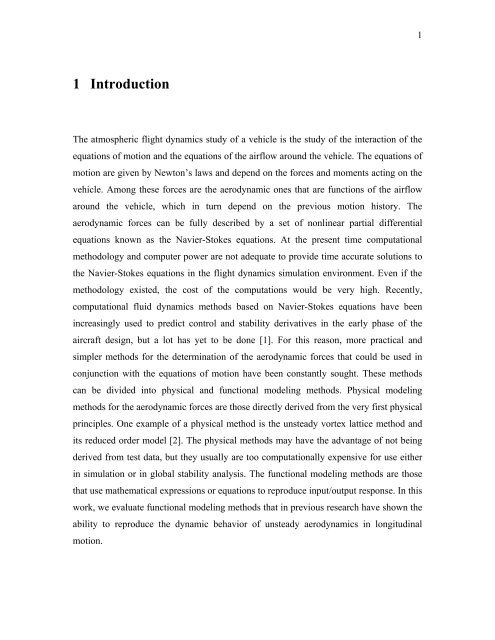Aircraft Stability Analysis Including Unsteady Aerodynamic Effects
Aircraft Stability Analysis Including Unsteady Aerodynamic Effects
Aircraft Stability Analysis Including Unsteady Aerodynamic Effects
Create successful ePaper yourself
Turn your PDF publications into a flip-book with our unique Google optimized e-Paper software.
11 IntroductionThe atmospheric flight dynamics study of a vehicle is the study of the interaction of theequations of motion and the equations of the airflow around the vehicle. The equations ofmotion are given by Newton’s laws and depend on the forces and moments acting on thevehicle. Among these forces are the aerodynamic ones that are functions of the airflowaround the vehicle, which in turn depend on the previous motion history. Theaerodynamic forces can be fully described by a set of nonlinear partial differentialequations known as the Navier-Stokes equations. At the present time computationalmethodology and computer power are not adequate to provide time accurate solutions tothe Navier-Stokes equations in the flight dynamics simulation environment. Even if themethodology existed, the cost of the computations would be very high. Recently,computational fluid dynamics methods based on Navier-Stokes equations have beenincreasingly used to predict control and stability derivatives in the early phase of theaircraft design, but a lot has yet to be done [1]. For this reason, more practical andsimpler methods for the determination of the aerodynamic forces that could be used inconjunction with the equations of motion have been constantly sought. These methodscan be divided into physical and functional modeling methods. Physical modelingmethods for the aerodynamic forces are those directly derived from the very first physicalprinciples. One example of a physical method is the unsteady vortex lattice method andits reduced order model [2]. The physical methods may have the advantage of not beingderived from test data, but they usually are too computationally expensive for use eitherin simulation or in global stability analysis. The functional modeling methods are thosethat use mathematical expressions or equations to reproduce input/output response. In thiswork, we evaluate functional modeling methods that in previous research have shown theability to reproduce the dynamic behavior of unsteady aerodynamics in longitudinalmotion.
















